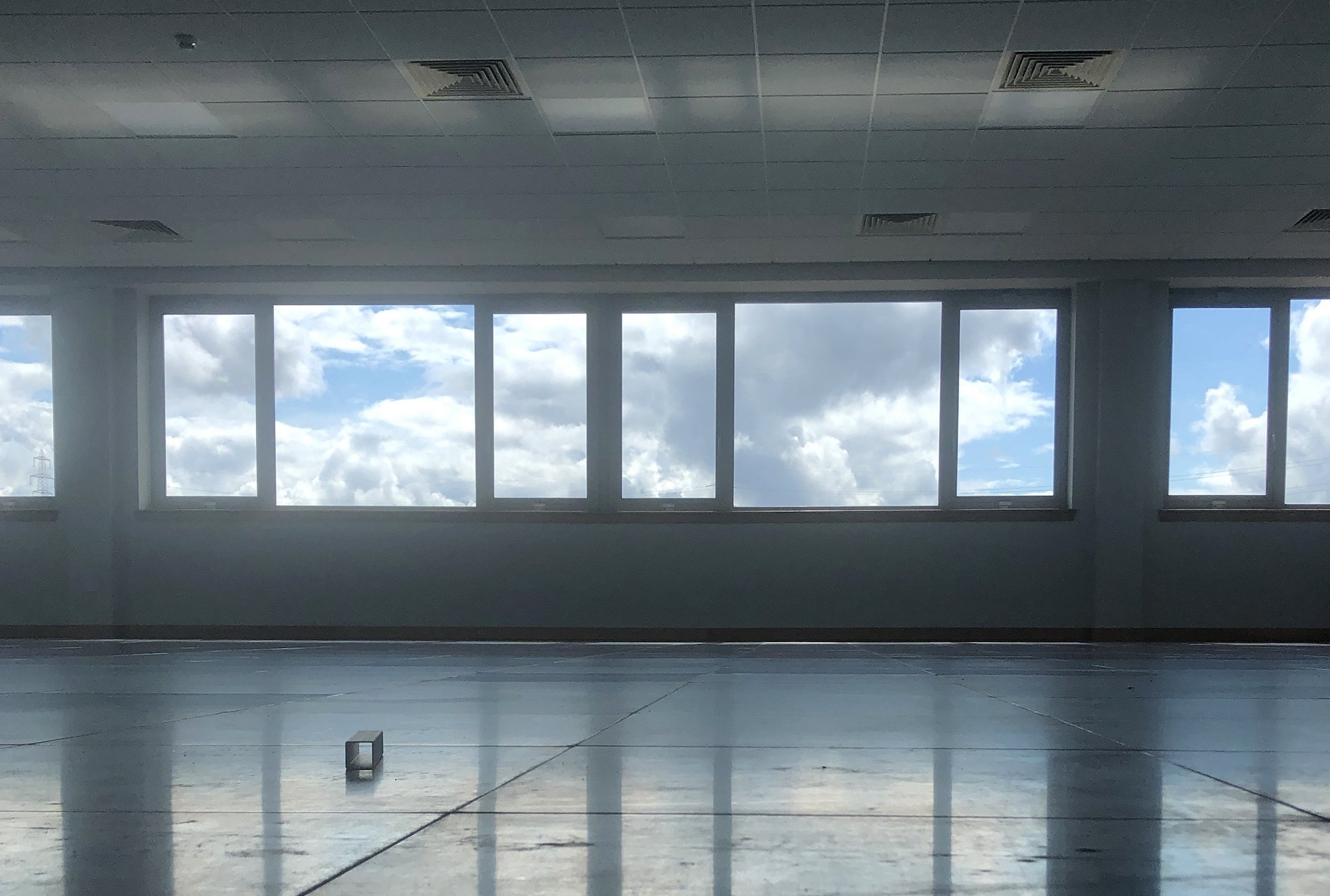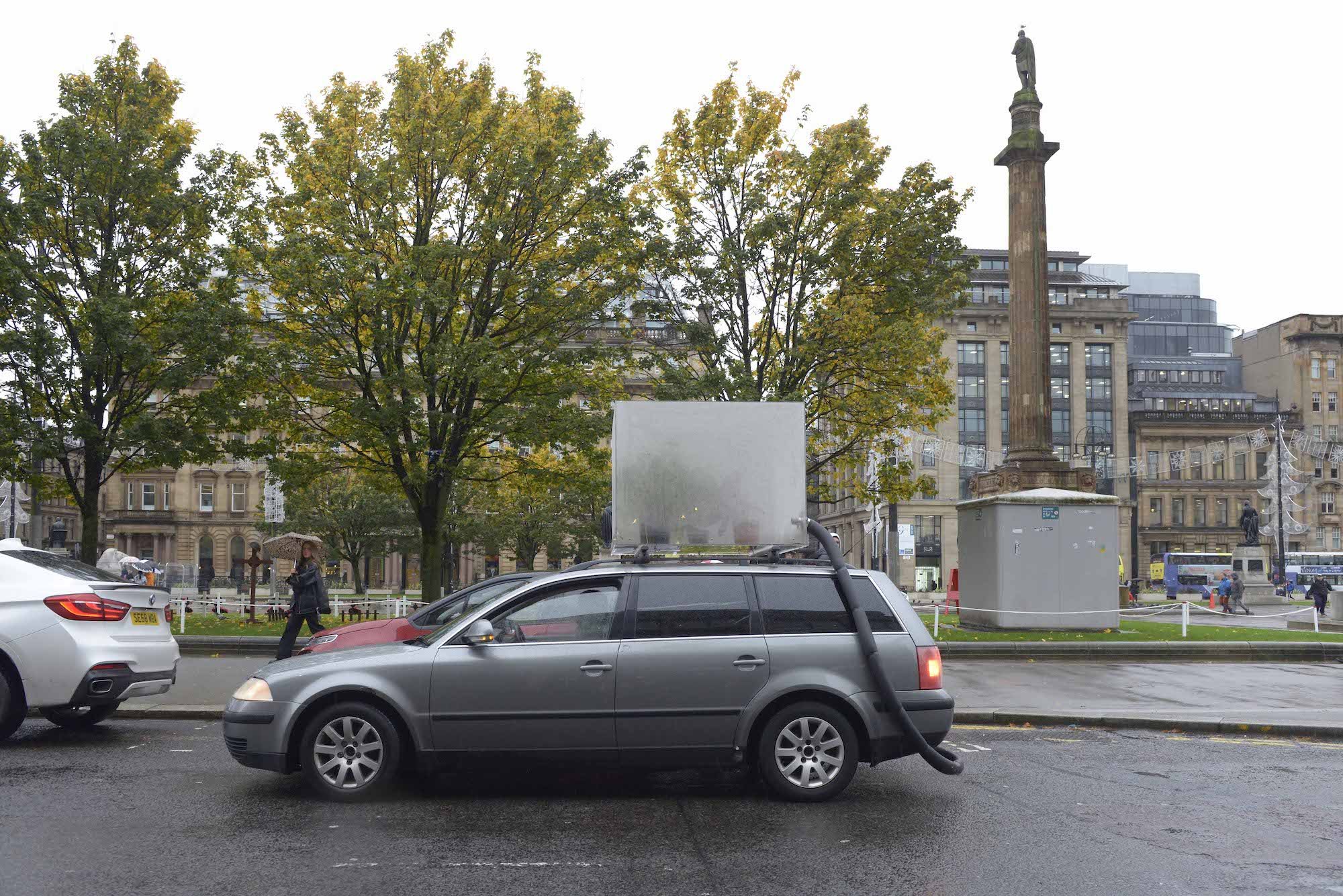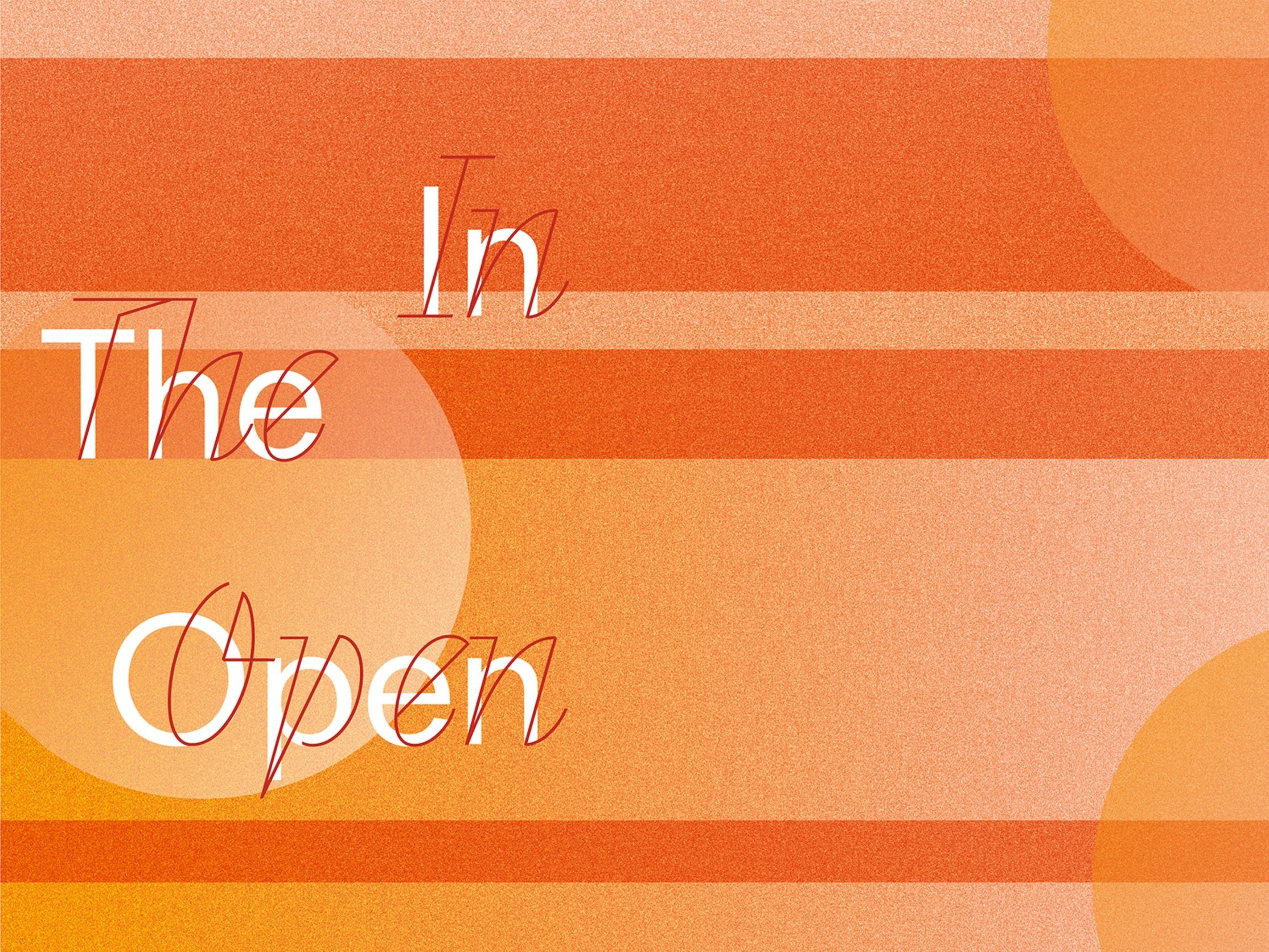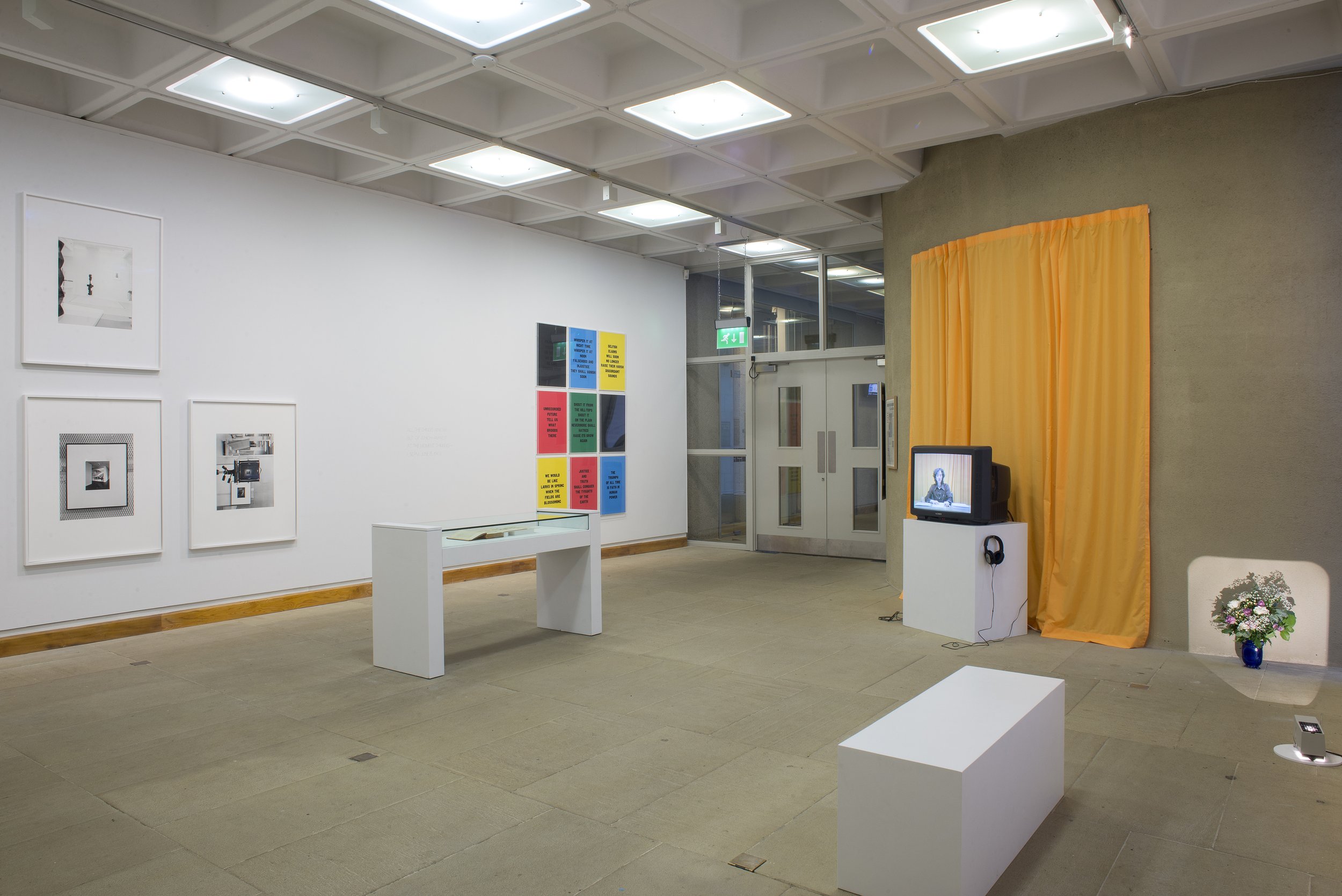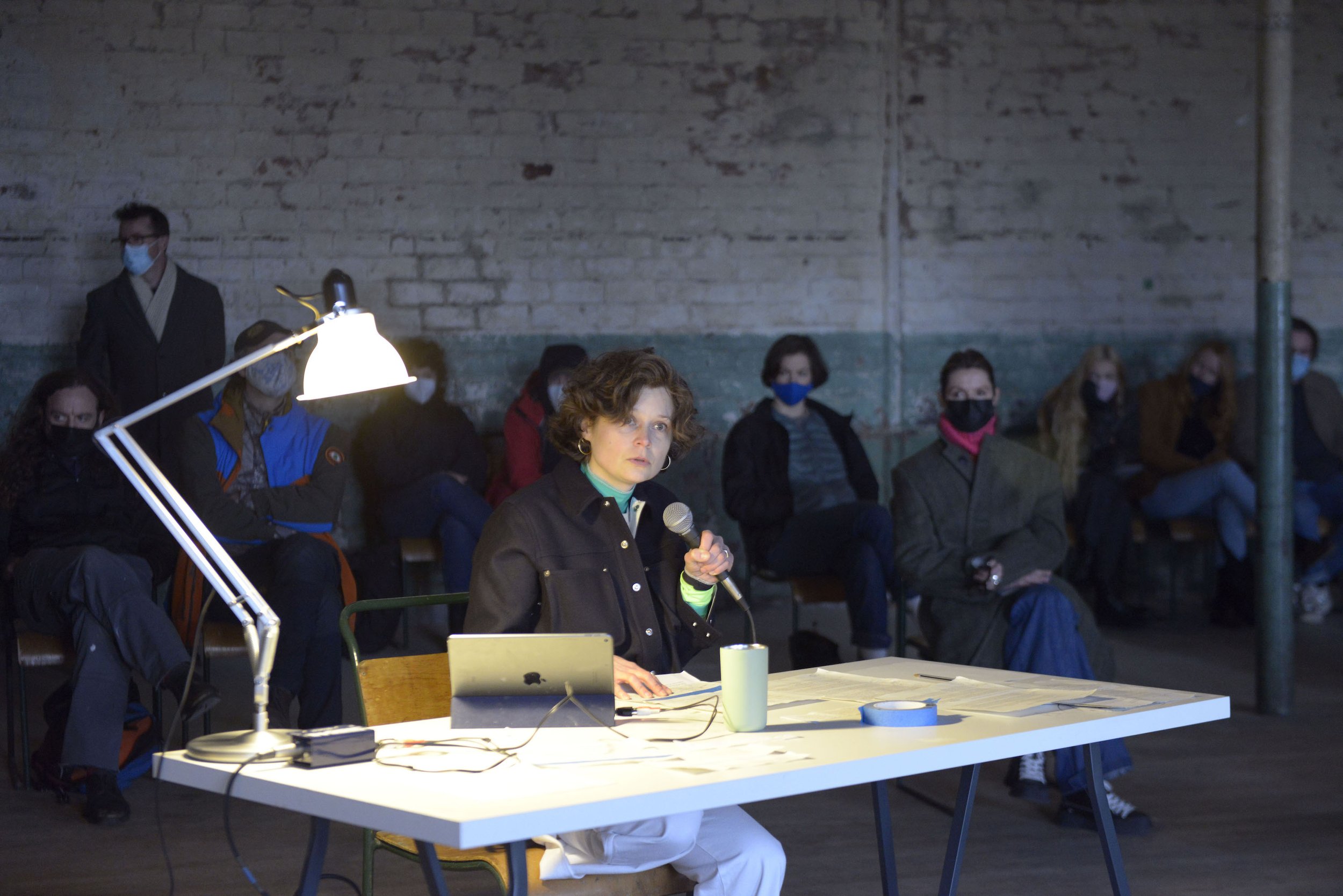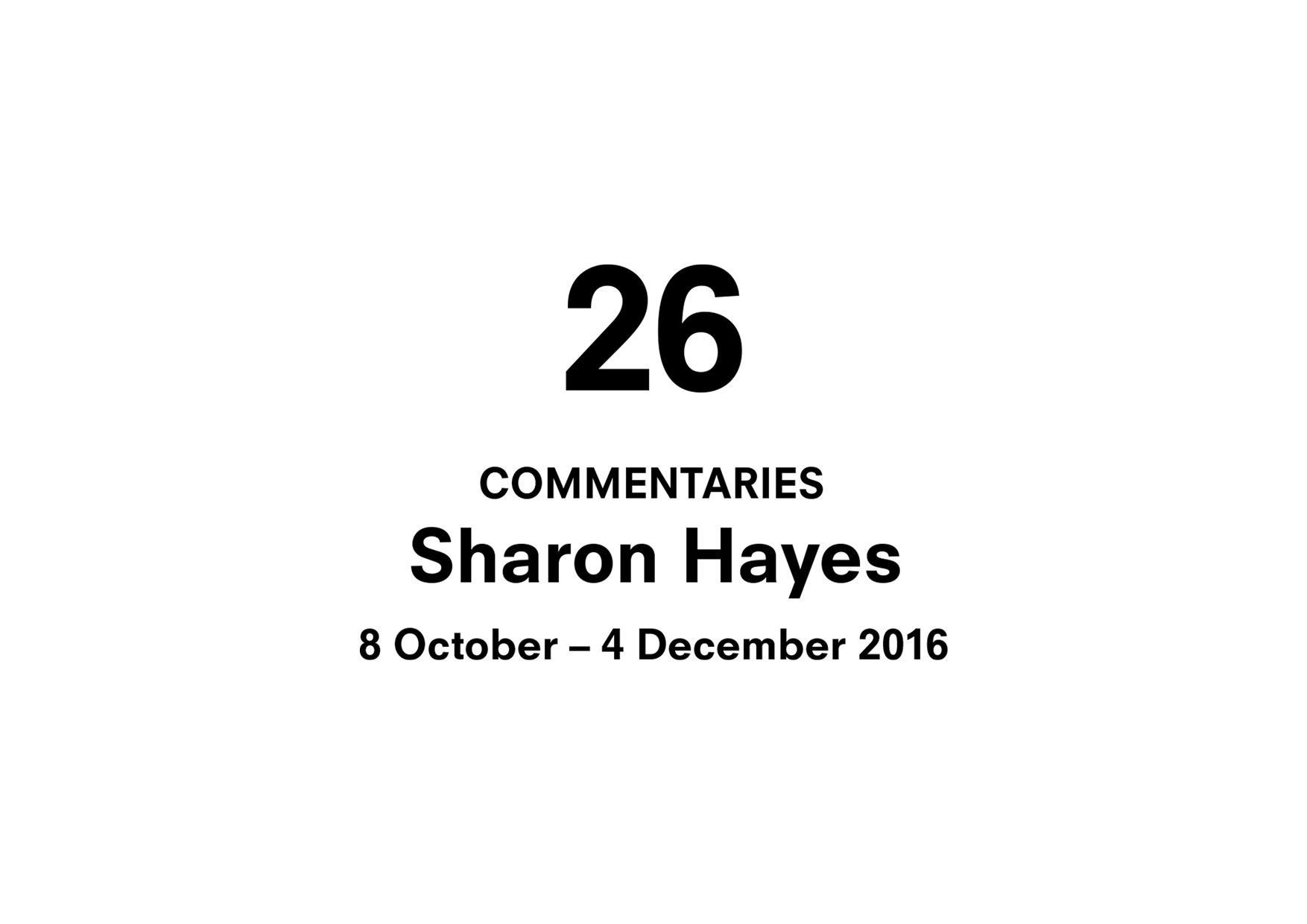
Artist Talk / Sharon Hayes
Sharon Hayes, ‘Ricerche: two’ (2020). Installation view, The Common Guild at the former Adelphi Terrace Public School, Glasgow. Photo: Isobel Lutz-Smith.
Earlier this year, American artist Sharon Hayes presented a new project, 'Ricerche', at the former Adelphi Terrace Public School, bringing together Hayes’ three ‘Ricerche’ films for the first time and including the artist’s latest major work, 'Ricerche: two' (2020), which was commissioned by The Common Guild.
Hayes’ ‘Ricerche’ (or ‘research’) project constitutes an examination of gender, sexuality and contemporary collective identifications. It continues Hayes' sustained investigation of the act of public speech, and its intersections with history, politics, activism, queer theory, love and sexuality, through both the collective and the individual voice.
Sharon Hayes joined us online for a discussion of this project and the making of 'Ricerche: two' (2020), which was filmed in Dallas/Fort Worth, Texas, with two women’s tackle football teams.
Sharon Hayes, ‘Ricerche: two’ production still, Dallas/Fort Worth, Texas, February 2020. Courtesy of the artist and Tanya Leighton, Berlin.
Sharon Hayes (b. 1970, Baltimore, Maryland, USA) lives and works in Philadelphia, USA.
Hayes is one of the most influential politically and socially committed artists working in the United States. She has been the subject of retrospectives at the Whitney Museum of American Art, New York; Museo Nacional Centro de Arte Reina Sofía, Madrid; and Moderna Museet, Stockholm. Hayes’ work is part of the public collections of Tate, London; Museum of Modern Art, New York; Solomon R. Guggenheim Museum, New York; Whitney Museum of American Art, New York; Dallas Museum of Art; San Francisco Museum of Modern Art; Kunstmuseum St. Gallen; Museum of Modern Art Warsaw, Warsaw; among many others. Hayes’ 5-channel video installation 'In My Little Corner of the World, Anyone Would Love You’ (2016) was co-commissioned by The Common Guild and Studio Voltaire, London.
Sharon Hayes holds the position of Professor of Fine Arts at the University of Pennsylvania.
Event Details
This talk took place on Zoom on Thursday 16 December, 6–8pm. You can watch back until 31 January 2022.
Related

Roundtable Conversation with Ashanti Harris, Winnie Herbstein, and Mathew Wayne Parkin
Sharon Hayes, ‘Ricerche: one’ (2019). Film still. Courtesy of the artist and Tanya Leighton, Berlin
Roundtable Conversations offer space for dialogue and the opportunity to develop ideas prompted by exhibitions and projects.
Artists Ashanti Harris, Winnie Herbstein and Mathew Wayne Parkin offer their reflections and provocations on the work of Sharon Hayes, in an informal group discussion, drawing upon their own research and work as practising artists.
Event Details
Places are limited and booking is required.
All participants are encouraged join in the discussion.
Related

Pier Paolo Pasolini – 'Comizi d'amore' (Love Meetings)
Pier Paolo Pasolini, ‘Comizi d’amore’ (1964). Film Still.
Courtesy of Compass Films / Instituto Luce Cinecittà.
A special screening of Pier Paolo Pasolini’s feature-length documentary ‘Comizi d’amore’ (Love Meetings) (1964) to accompany Sharon Hayes, 'Ricerche'. The film will be introduced by Dr Pasquale Iannone (University of Edinburgh).
Developed during a period of rapid modernisation and socioeconomic transformation across Italy, ‘Comizi d’amore’ examines Italian attitudes towards sex and sexuality, relationships, gender and contemporary collective identifications.
The film follows Pasolini and a small camera crew through Italy where, at beach resorts, town centres, universities, fields and factories, they interview groups of students, children and co-workers. Filmed in the cinéma- vérité style, Pasolini himself often appears just out of shot with microphone extended, posing questions which reveal their subjects’ freedoms and prejudices, or “inversions” and “perversions”. Pasolini divides this cinematic report into a series of ‘ricerches’ or researches.
Event Details
Screening Information
Italian with English subtitles
89 minutes
Compass Films / Instituto Luce Cinecittà
Further Info
Additional Links
This event was part of Sharon Hayes ‘Ricerche’
Related

Sharon Hayes – 'Ricerche'
Sharon Hayes, 'Ricerche: two' (2020) Film still, Pictured: Courtnei “Luckey” Townson.
Courtesy of the artist and Tanya Leighton, Berlin and Los Angeles.
American artist Sharon Hayes’ new project with The Common Guild is a suite of three films, shown together for the first time. It is the continuation of Hayes’ on-going ‘Ricerche’ project, including a new commission. ‘Ricerche’ (meaning ‘research’) is comprised of several video works that use the 1964 film ‘Comizi d’Amore’ (Love Meetings) by Italian director, Pier Paolo Pasolini, as a guidepost and framework for an examination of gender, sexuality and contemporary collective identifications.
‘Ricerche’ constitutes an inquiry into the relations between sex, sexuality, gender and politics in the United States today, with nonetheless striking resonance with contemporary discourse across societies elsewhere. It continues Hayes investigation of the act of public speech, and its intersections with history, politics, activism, queer theory, love and sexuality, through both the collective and the individual voice.
Filmed by Hayes at different times since 2013, including during 2020’s critical election year in the US, the works feature a range of individuals, from students at an all-women’s college in Massachusetts, to children of queer or gender non-conforming parents, and members of two women’s tackle football teams. Each film is presented as ‘ricerche’ or research. The most recent, ‘Ricerche: two’, was filmed in Dallas/Fort Worth, Texas, just before the onset of the pandemic. It was commissioned by The Common Guild. The extended interview asks the players what they like about the sport, whether they feel different on and off the field and how playing football relates to other aspects of their lives. This new work will be presented alongside the two existing works in the series; the single-channel video ‘Ricerche: three’ (2013), and a diptych, ‘Ricerche: one’ (2019).
Sharon Hayes, ‘Ricerche: two’ (2020). Installation view, The Common Guild at the former Adelphi Terrace Public School, Glasgow. Photo: Isobel Lutz-Smith.
‘Ricerche’ is presented in the former Adelphi Terrace Public School, south of the river Clyde, opposite Glasgow Green. Originally opened in 1894 following the Education (Scotland) Act of 1872, which made schooling free and compulsory for five to thirteen year olds, the building was used as a site of education for children and young adults until 2010. With thanks to our venue partner Urban Office.
Sharon Hayes (b. 1970, Baltimore, Maryland, USA) lives and works in Philadelphia, USA.
Hayes is one of the most influential politically and socially committed artists working in the United States. She has been the subject of retrospectives at the Whitney Museum of American Art, New York; Museo Nacional Centro de Arte Reina Sofía, Madrid; and Moderna Museet, Stockholm. Hayes’ work is part of the public collections of Tate, London; Museum of Modern Art, New York; Solomon R. Guggenheim Museum, New York; Whitney Museum of American Art, New York; Dallas Museum of Art; San Francisco Museum of Modern Art; Kunstmuseum St. Gallen; Museum of Modern Art Warsaw, Warsaw; among many others. Hayes’ 5-channel video installation 'In My Little Corner of the World, Anyone Would Love You’ (2016) was co-commissioned by The Common Guild and Studio Voltaire, London.
Sharon Hayes holds the position of Professor of Fine Arts at the University of Pennsylvania.
Further Info
With thanks to Tanya Leighton, Berlin and Los Angeles.
Documents
E-flux Announcement – Sharon Hayes: ‘Ricerche’
Sharon Hayes interviewed by Adam Benmaklouf, The Skinny, October 2021
Related

Roundtable Conversation / Mathew Parkin & Mason Leaver-Yap – 'Meet me at The Vintners (What you're looking for is looking for you)'
Image courtesy of Mathew Parkin and Mason Leaver-Yap.
'I told the participants that I wasn't going to be investigating into who they were specifically. They didn't have to answer authentically. I was interested in who ever they wanted to be when they showed up in front of a camera. That is to say, I was interested in the many "whos" they are, the many personas that they channel or that they occupy.'
Sharon Hayes describing the making of 'Ricerche: three', (2013)
Join Mathew Parkin and Mason Leaver-Yap at The Vintners, a former Glasgow gay bar and imaginary space for staging communal conversation, revisiting queer histories and engaging in discourse on collective identity.
The discussion will be informed and embedded in the context of Sharon Hayes’ Ricerche series of films (2013–ongoing), particularly 'Ricerche: three' (2013) which was filmed with students of the all-women’s college Mount Holyoke in Massachusetts.
Participants assemble as a collaborative learning group to understand constructions of togetherness and individuality. The virtual space of The Vintners serves as a backdrop to a series of guided exercises, short screenings, and conversational prompts. This gathering will instigate the development of a few collective questions, with an eye on recent queer history and its relevance to the here and now.
Mathew Parkin is an artist, writer and home cook mainly working with moving-image, family and friends. They are based in Glasgow and have recently been in residence at Art House, CCA Glasgow and Hospitalfield Arts. Recent public projects have been with LUX Scotland, Tramway, Grand Union and IMT Gallery.
Mason Leaver-Yap works with artists to produce texts, exhibitions, and events. Based in Glasgow and Berlin, they are currently working with Iman Issa, Onyeka Igwe, Lucy McKenzie, Lin+Lam, Andrea Büttner, Renée Green, and Ingrid Pollard.
Sharon Hayes is one of the most influential politically and socially committed artists working in the United States. She has been the subject of retrospectives at the Whitney Museum of American Art, New York; Museo Nacional Centro de Arte Reina Sofía, Madrid; and Moderna Museet, Stockholm. ‘Ricerche’ is an ongoing project composed of multiple video works that use Pier Paolo Pasolini’s 1964 film, ‘Comizi d’amore’ (Love Meetings), as a guidepost and framework for an examination of gender, sexuality and contemporary collective identifications. It continues Hayes’ investigation of the act of public speech, and its intersections with history, politics, activism, queer theory, love and sexuality, through both the collective and the individual voice.
Event Details
An online collective learning group with Mathew Parkin and Mason Leaver-Yap responding to Sharon Hayes’ Ricerche films.
The Vintners was open for one night only and had capacity for 15 people. As an online gay bar it was open to the messiness and solidarity that one would expect IRL. Participants were requested to self-select their participation on that basis.
Related

Sharon Hayes – 'Ricerche: three'
Sharon Hayes ‘Ricerche: three’ (2013), Single channel HD video, 38 minutes
Participants: Jasmine Brown, Laakan McHardy, Paola Lopez, Anarkalee Perera, Zehra Ali Khan, Sara Amjad
Courtesy of the artist and Tanya Leighton, Berlin.
This month, we are delighted to announce the online screening of a film by Sharon Hayes, whose project we were due to present for this year’s Glasgow International, now postponed to 2021. The first in a suite of works, 'Ricerche: three' (2013), is available for viewing here from the 11th until 31st May.
Viewing Sharon Hayes’ 'Ricerche: three' in what is now the second month of confinement, is to experience the impossible, taboo even. Filmed in 2013 with students from Mount Holyoke women’s college in Massachusetts, 'Ricerche: three' shows us the prolonged and intimate sharing of public space with a group of other people. This simple representation of keeping company with others is all the more exuberant watched from the confines of our temporarily (and necessarily) abandoned public sphere.
Buzzing with dialogue, chatter and the joy of animated discourse 'Ricerche: three' offers liveness and interaction. Real physical embraces, gesticulations of emotion, expressions of disagreement, laughter and the pleasure of talk ring out, even during the film's imposed silences. Whilst we are unable to experience crowds and participate in the immediacy of debate, Hayes’ film is an invitation to gather together, to listen and to exchange values.
'Ricerche: three' is in fact the first in a long-term and currently ongoing investigative film series observing attitudes around sex, relationships, gender and nationhood in contemporary American society. The word ‘ricerche’ - Italian for research - is borrowed, along with Hayes’ frank methodological enquiry, from Pier Paolo Pasolini’s 1964 film ‘Comizi d’amore’, a documentary investigation into the sexual attitudes of Italians during the 1960s.
Following Pasolini, the conversation staged and structured by Hayes draws its international participants, who identify across a wide gender spectrum, into dialogues centring around queer and feminist politics, self-definition, the importance of sexual and gender identity, and the influence of culture and religion on sexual, political and ideological freedoms. Through Hayes’ open questioning, a politics of the personal, social and communal emerges, giving voice to the schisms in operation within the private, self-selecting community of the university and public life beyond this space.
The film demonstrates the often difficult nature of expression, of forming an opinion, holding firm beliefs, and maintaining a political position. It reminds us that the kinds of closeness and proximity with others encouraged by university education breeds astute, reflective and engaged individuals which in turn develops networks of ideas; something that cannot be replicated so well through distanced learning.
To watch 'Ricerche: three' is to witness collective thinking in action: urgent, impassioned, messy talk articulated in real time. Spending time with these students as they establish antagonistic consensus and form a disparate collective identity is to participate in a shared experience that invokes the observer to take part, respond, and to shape change.
Project Details
‘Ricerche: three’ was available to watch online for a limited time in May 2020. We are grateful to Sharon Hayes and Tanya Leighton, Berlin for allowing us to share this film.
'Ricerche: three' (2013)
Single Channel HD Video (Colour, Sound)
38 minutes
Participants: Aderike Ajao, Zehra Ali Khan, Sara Amjad, Eirie Blair, Emma Boisselle, Eoin Bradley, Lisa Brea, Jasmine Brown, Octavia Cephas, Miran Chowdhury, Julia Corsetti, Jenny Daniels, Laura Donovan, Lyla Eaton, Caden Friedenbach, Tess Guilfoile, Keenan Hale, Liz Honorato, Pavel Lopez, Laakan McHardy, Alexandra Menter, Michelle Olguin, Tejumolu Onabajo, Jessica Ortiz, Jinyoung Park, Yesenia Parra, Anarkalee Perera, Shelley Picot, Karishma Reddy Khan, Naomi Rodri, Liz Sandman, Alyssa Simari, Poorna Swami, Suleidys Tellez, Caitlin Utter, Summer Yun Zhou
Production Credits:
Director: Brooke O’Harra
Director of Photography: Michelle Lawler
Cameras: Mike Crane, James Kienitz Wilkins, Lucretia Knapp, Nathan McGarigal Sound Recorder: EE Miller
Sound Mix: Josh Allen
Production Managers: Amber Bemak, Karishma Reddy Khan
Original Exhibition Design: Nanna Wülfing
Related
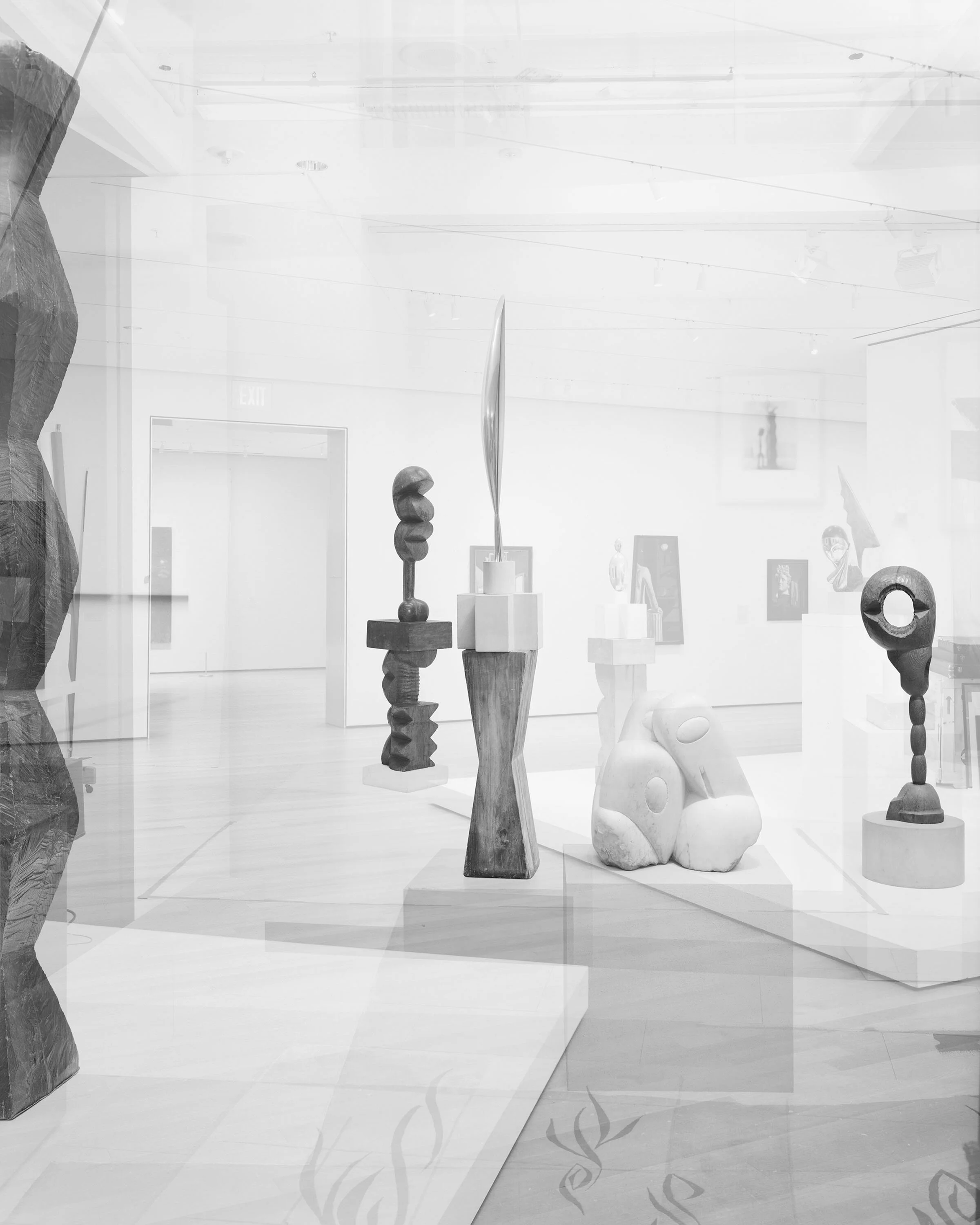
'A Synchronology: the contemporary and other times' – Robert Barry, Gerard Byrne, Phil Collins, Ruth Ewan, Sharon Hayes, Simon Starling, Corin Sworn and others
Simon Starling, 'Pictures for an Exhibition' 2013-2014. #12 of 36 Constantin Brancusi, Endless Column (1918), Adam & Eve (1916–21), Bird in Space (1926), Three Penguins (1911–12), Socrates (1922) (left to right).
Courtesy the Artist and The Modern Institute/Toby Webster Ltd, Glasgow.
Curated by Dr Dominic Paterson for the the University of Glasgow’s Hunterian Art Gallery, ‘A Synchronology’ is a new exhibition marking The Common Guild's 10th anniversary.
Taking its cue from the programme of exhibitions and projects we have realised since coming into being in 2007, the exhibition features several leading international artists and includes a diverse range of works that nonetheless share an interest in temporality: in marking time and in the presence of the past.
In our ten-year existence, The Common Guild has established itself as a leading force in contemporary visual arts in the UK. We curated Scotland’s participation in the 55th Venice Biennale in 2013, commissioning work by Corin Sworn, Hayley Tompkins and Duncan Campbell, who subsequently won the Turner Prize. The Common Guild has also worked closely with the University of Glasgow to present artist’s talks, symposia and other events, and ‘A Synchronology’ extends this collaboration.
The exhibition includes works by Robert Barry, Gerard Byrne, Phil Collins, Ruth Ewan, Sharon Hayes, Simon Starling and Corin Sworn and among others.
Further info
Supported by
Related
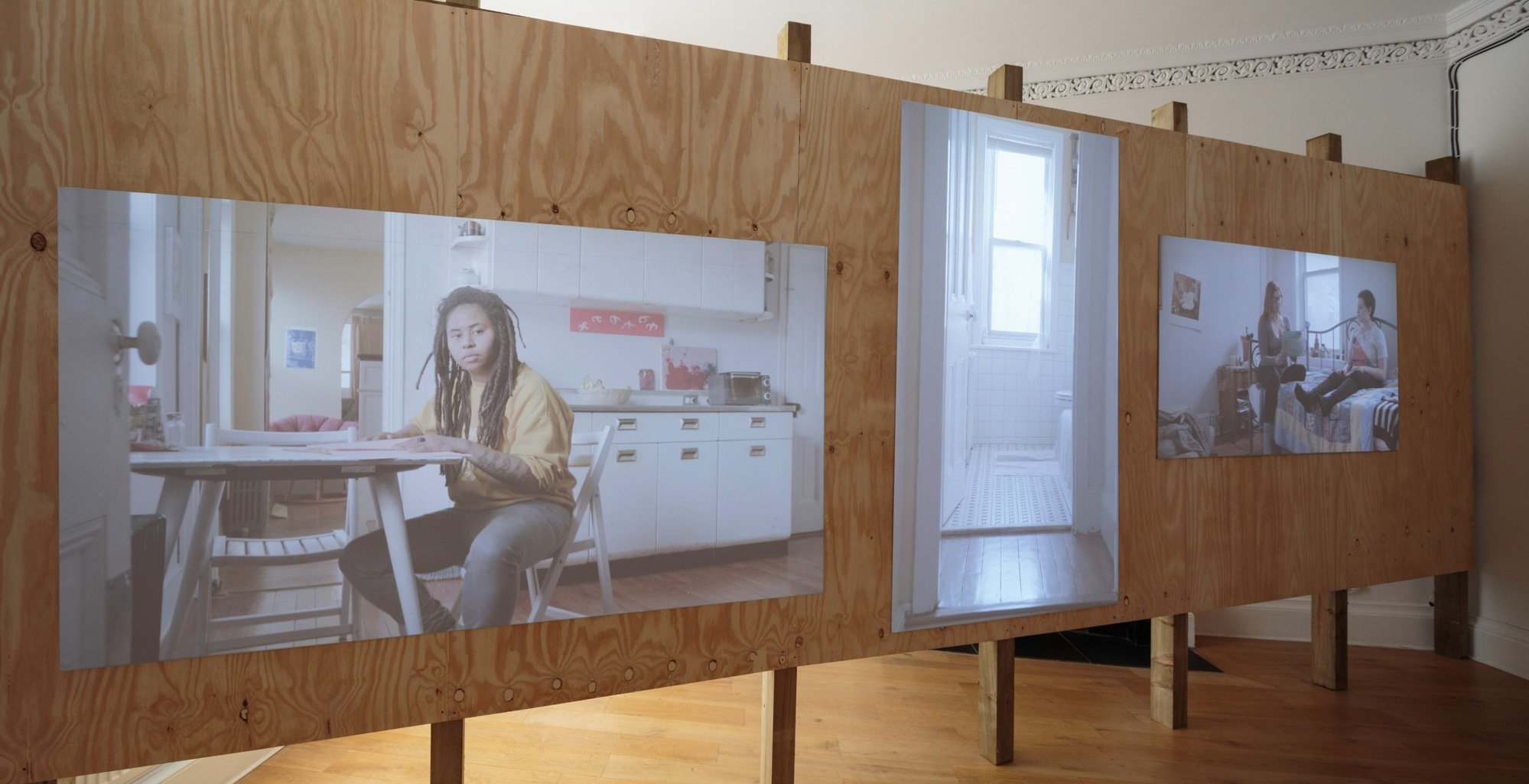
Exhibition Talk / Dr Francesca Stella on Sharon Hayes
Sharon Hayes, ‘In My Little Corner of the World, Anyone Would Love You’ (2016). Installation view, The Common Guild. Photo: Ruth Clark
Dr Francesca Stella is Lecturer in Sociology at the University of Glasgow, and a member of the Socialist Theory and Movements Research Network, and the Gender and Sexualities Forum.
Dr Stella’s research focuses on sexuality and gender (particularly queer lives and communities). She is interested in storytelling as a means of public engagement and discusses her research in relation to Sharon Hayes' work.
Event Details
Listen to Dr Francesca Stella –
Related

Artist Talk / Sharon Hayes in conversation with Alice Andrews
Sharon Hayes, ‘In My Little Corner of the World, Anyone Would Love You’ (2016). Installation view, The Common Guild. Photo: Ruth Clark
American artist Sharon Hayes is joined in conversation with Alice Andrews of Glasgow Women’s Library on the occasion of Hayes’ presentation of ‘In My Little Corner of the World, Anyone Would Love You’ at The Common Guild.
Hayes’ project draws upon archival newsletters and small-run publications from the US and UK produced by lesbian, feminist and effeminist political collectives in the 1960s and 1970s, including those held in the archive of Glasgow Women’s Library. Hayes’ and Andrews’ discuss the significance of these archives, the relationship between communication and isolation, as well as the critical debates that circulated in the early formation of lesbian, feminist and gay liberation political positions.
Event Details
Listen to Sharon Hayes and Alice Andrews –
Related

Sharon Hayes – 'In My Little Corner of the World, Anyone Would Love You'
Sharon Hayes, 'In My Little Corner of the World, Anyone Would Love You' (2016). Video Still. Performers left to right - Jeannine Betu Kayembe and Karl Surkan. Courtesy of the artist and Tanya Leighton Gallery, Berlin.
'In My Little Corner of the World, Anyone Would Love You’ is a new exhibition by the American artist Sharon Hayes. Hayes’ work often explores the role of the individual voice within a wider political history, and this exhibition draws on queer and feminist archives in the US and the UK to focus on gay liberation, women’s liberation and the political groups that preceded lesbian and transgender liberation between 1955-77. The exhibition examines the ways in which political discourse is formed and political identities constructed through individual acts of writing and reading.
Sharon Hayes, ‘In My Little Corner of the World, Anyone Would Love You’, installation view, The Common Guild, 2016. Photo: Ruth Clark.
Hayes' research included the magazines, journals and newsletters produced by lesbian liberation groups, primarily ‘The Ladder’ (published by the American organisation Daughters of Bilitis between 1955-1972), and ‘Arena Three’ (published by the British organisation Minorities Research Group between 1963-1972). She also draws on newsletters published by groups who existed for a much shorter period, from a few months to a few years. The exhibition includes material from a number of archives around the world, including Glasgow Women’s Library, which has a significant collection of lesbian and feminist publications.
Hayes’ work engages the intimacies of political collectives - both at times when movements are ascendant and at those times when they fail. Working from the content and form of archival materials, particularly the vast field of newsletters, 'In My Little Corner of the World, Anyone Would Love You’ restages the affective forms of organisation she encountered in the archives. Organisation of labour, of community, of communication and public relations are of specific interest, as are the conflicts, both personal and political, that surface frequently in these newsletter communications over the specific limits of gender, the regulation of gender expression and the fierce racisms that many lesbian, queer and trans people of colour encountered inside various of these political movements.
Further Info
Additional Links
Project Details
'In My Little Corner of the World, Anyone Would Love You’ was co-commissioned by The Common Guild and Studio Voltaire, London.
The commission was supported by Cockayne – Grants for the arts and The London Community Foundation, Charlotte Ford, Haro & Bilge Cumbusyan and Valeria & Gregorio Napoleone.
With thanks to Glasgow Women's Library.
Read the Commentary by Laura Guy –
Related

Room for Reading / 2016
Room for Reading features publications about and selected by exhibiting artists in our programme.
Throughout 2016, our Room for Reading selections feature publications chosen and inspired by Ulla von Brandenburg, Akram Zaatari, Simon Starling and Sharon Hayes, artists we are working with on current and upcoming projects.
Ulla von Brandenburg: Whose beginning is not, nor end cannot be’ (2008); Innen ist nicht Außen (Inside is not Outside) (2013) ; and Formerly Elentiere (2008)
In advance of Ulla von Brandenburg’s performance ‘Sink Down Mountain, Rise Up Valley’ at Langside Halls on the 30th and 31st of January, we have selected three publications on the artist’s work.
‘Whose beginning is not, nor end cannot be’ was published on the occasion of Von Brandenburg’s exhibition at the Irish Museum of Modern Art in Dublin in 2008. The publication features essays by Declan Long and Beatrix Ruf, as well as an interview between the artist and Rachel Thomas.
‘Innen ist nicht Außen (Inside is not Outside)’ was published in 2013 to accompany an exhibition of the same name at Vienna Secession. It features texts by Nina Möntmann, András Pálffy, Annette Südbeck and René Zechlin.
‘Ulla Von Brandenburg. Formerly Elentiere’ (2008) was published following the exhibition, ‘Where a red net lies over the green’ at the Kunstverein für die Rheinlande und Westfalen, Düsseldorf, 2008, and features texts by Nina Möntmann and Vanessa Joan Müller.
Antoine Picon, ‘The Saint-Simoniens: Reason, Imagination and Utopia’ (2002)and Ralph P. Locke ‘Music, Musicians and the Saint-Simonians’ (1986).
Von Brandenburg selects ‘The Saint-Simoniens: Reason, Imagination and Utopia’ by Antoine Picon (2002), in which Picon discusses Saint-Simonianism, an influential utopian movement in 19th Century France, paying special attention to Saint-Simonian ideas about architecture and public space.
Von Brandenburg’s second selection Music, Musicians and the Saint-Simonians’ (1986) by Ralph P. Locke outlines Saint-Simonian approaches to music as an ideological tool.
Read ‘The Saint-Simoniens: Reason, Imagination and Utopia’ here.
Akram Zaatari, ‘Akram Zaatari: A Conversation with an Imagined Israeli Filmmaker Named Avi Mograbi’ (2012); ‘Time Capsule, Kassel 24/25.05.2012’ (2013), 'Film as a Form of Writing: Quinn Latimer talks to Akram Zaatari’ (2014).
As Akram Zaatari, ‘The End of Time’ opens at 21 Woodlands Terrace, the artist has made a selection of books to accompany the exhibition.
The first is 'Akram Zaatari: A Conversation with an Imagined Israeli Filmmaker Named Avi Mograbi’ published by Sternberg Press, 2012. During a residency at Les Laboratoires d'Aubervilliers, Zaatari attempted to write, improvise, and deliver a conversation with an imagined Israeli filmmaker, giving him the name Avi Mograbi. Zataari used this fictional character as a device to revisit photographs he made during the Israel occupation of his hometown in 1982, imagining what could have been experienced by an Israeli filmmaker in this time.
'Akram Zaatari: Time Capsule, Kassel 24/25.05.2012' is a postscript to the exhibition 'This Day at Ten' at MAGASIN - Centre National d'Art Contemporain de Grenoble, 2013. Inspired by an act of conservation that the founder of the National Museum in Beirut undertook on the eve of the civil war in 1975–6, ‘Time Capsule, Kassel’ is, in the artist's words, a statement about speculation, photography, time and withdrawal.
'Film as a Form of Writing: Quinn Latimer talks to Akram Zaatari’ (2014) is an in-depth interview between the artist and critic Quinn Latimer. In the interview Zaatari describes his work: “as with most of my work, it is made for time; it is both a testimony of where I come from and a mark I care to leave for the future—again as thought, not as data or records. Let’s call it alternative writing that uses the form of letters.”
Read Quinn Latimer on Akram Zaatari in Artforum here.
Watch a short film by Akram Zaatari about ‘Time Capsule, Kassel’ here.
Karl Bassil, Zeina Maasri and Akram Zaatari, 'Mapping Sitting: On Portraiture and Photography'(2002)'; Karl Bassil and Akram Zaatari, ‘'EARTH of ENDLESS SECRETS' (2009); Akram Zaatari, All Is Well' (2014)
Zaatari also selects 'Mapping Sitting: On Portraiture and Photography' by Karl Bassil, Zeina Maasri, and Akram Zaatari (2002) which accompanied the eponymous exhibition curated by Walid Raad and Zaatari from the Arab Image Foundation. Featuring photographs taken between the 1920s and the 1970s, in Lebanon, Egypt, Iraq, Palestine and Jordan, it raises questions about portraiture, performance, photography and identity in the Arab world.
'EARTH of ENDLESS SECRETS' by Karl Bassil and Akram Zaatari (2009) examines Zaatari’s ongoing research project, unearthing and examining a wide range of documents that testify to the current cultural and political conditions of Lebanon.
Akram Zaatari’s 'All Is Well' (2014), published on the occasion of the artist’s first solo exhibition in Canada, addresses the complex history of the civil conflict in Lebanon. The publication explores the precarious status of archives in times of war, as well as their discursive limits as narrators of Lebanon’s history.
Read an interview with Zaatari on ‘Mapping Sitting’ published by MoMA here.
Watch a selection of excerpts from Zaatari’s films on Video Data Bank here.
Watch Zaatari speak about photography, memory and here.
Etel Adnan, ‘Sitt Marie-Rose’ (1982); Jibrail S. Jabbur, ‘The Bedouins and The Desert:Aspects of Nomadic Life in the Arab East’ (1995); Ariella Azoulay ‘From Palestine to Israel: A photographic Record of Destruction and State Formation, 1947-1950’ (2011).
In the final instalment of Akram Zaatari’s Room for Reading selections, the artist selects authors and critical works that describe aspects of Arab life.
'Sitt Marie-Rose (A Novel)' by Etel Adnan (1982) is set before and during the 1975-1990 Lebanese Civil War, and based on the life of Marie Rose Boulos who was executed by a Christian militia during the long conflict.
'The Bedouins and The Desert: Aspects of Nomadic Life in the Arab East' by Jibrail S. Jabbur (1995) is an extensively illustrated account of traditional bedouin life in the Arab east which recounts the history of the enigmatic Slayb tribe.
'From Palestine to Israel: A photographic Record of Destruction and State Formation, 1947-1950' by Ariella Azoulay, a photo book in which Azoulay reconstructs the processes by which the Palestinian majority in Mandatory Palestine became a minority in Israel.
Sonallah Ibrahim , ‘Zaat’ (2011); Jacques Derrida, ‘Archive Fever’ (1995).
Sonallah Ibrahim’s 'Zaat'(2001) tells the story of an Egyptian woman – the eponymous Zaat – during the regimes of three Egyptian presidents: Abdel Nasser, Sadat, and Mubarak.
'Archive Fever: A Freudian Impression' by Jacques Derrida (1995), a deconstructive analysis of the notion of archiving and an extended meditation on remembrance, religion, time, and technology, including the e-mail.
Read ‘Sitt Marie Rose’ here.
Read an excerpt from 'The Bedouins and The Desert: Aspects of Nomadic Life in the Arab East' here.
Listen to a talk by Ariella Aisha Azoulay ‘On Photography and Potential History’ here.
Read ‘Archive Fever: A Freudian Impression’ here.
Ezra Pound, ‘A Memoir of Gaudier-Brzeska’ (1970); David R. Clark, ‘W.B. Yeats & the Theatre of Desolate Reality’ (1965); Nobuko Tsukui, ‘Ezra Pound and the Japanese Noh Plays’ (1983).
To coincide with Simon Starling’s exhibition ‘At Twilight’, the artist has selected the following books for this month’s Room for Reading.
'A Memoir of Gaudier-Brzeska' (1970) by the modernist poet and writer Ezra Pound was first published in 1916. The 1970 edition brings together Pound’s original text with later writing on Henri Gaudier-Brzeska, the French sculptor with whom Pound had a friendship before the former was killed in World War One. Pound was a huge champion of Gaudier’s work and raised the profile of the artist both during his life and after his death.
'W.B. Yeats & the Theatre of Desolate Reality' (1965) by David R. Clark illustrates Yeats’ development as a dramatist, through close examination of four of the modernist poet, playwright and writer’s plays.
Starling has chosen two books on Noh Theatre, a Japanese form of dance-drama that has been performed since the 14th Century. 'Ezra Pound and Japanese Noh Plays' (1983) by Nobuko Tsukui, and 'The Noh Theatre of Japan' (1959) by Ernest Fenollosa and Ezra Pound. Starling has also selected 'A Guide to Kyogen' (1968) by Don Kenny, a book designed as a basic guide for the viewer of a Kyogen performance containing synopses of all the plays in the present repertoire of the Kyogen practice.
'Stone Cottage: Pound, Yeats & Modernism' (1988) by James Longenbach details the period between 1913-16 during which W.B Yeats developed his autobiographies and Noh-style plays with the help of Ezra Pound.
Finally, Starling selects 'Four Plays for Dancers' (1921) by W.B.Yeats, which includes 'At the Hawks Well' a play by that was written and performed 100 years ago and is at the heart of Simon Starling and Graham Eatough’s ‘At Twilight: A play for two actors, three musicians, one dancer, eight masks (and a donkey costume)’.
Read ‘A Memoir of Gaudier-Brzeska' here and read more about Yeats and Brzeska here.
Read ‘The Collected Plays of W.B. Yeats’ (1963) published by MacMillan here.
Sharon Hayes
Francesco Bonami and Gary Carrion-Murayari, ‘2010’ (2010); ‘Sharon Hayes, ‘There’s So Much I Want To Say To You’ (2012) ; ‘Il Palazzo Enciclopedico’ (2013).
As Sharon Hayes’ exhibition 'In My Little Corner of the World, Anyone Would Love You’ opens to the public, we have selected three publications that focus on the artist’s earlier work.
Sharon Hayes, 'There's So Much I Want To Say To You' (2012) was published in conjunction with Hayes eponymous exhibition at the Whitney Museum of American Art in 2012 which brought together works, all of which articulate forms of what Hayes calls “speech acts”.
Hayes’ ‘Ricerche: three’ (2013) was commissioned and presented as part of ‘Il Palazzo Enciclopedico’ (The Encyclopedic Palace) curated by Massimiliano Gioni on the occasion of the exhibition at the 55th International Art Exhibition of La Biennale di Venezia. The catalogue is included here.
Our final recommendation is the catalogue accompanying the 2010 Whitney Biennial, titled ‘2010’, curated by Francesco Bonami and Gary Carrion-Murayari, in which Hayes’ work ‘Parole’ (2010) was included.
Read more about ‘There’s So Much I Want To Say To You’ here.
Read Massimiliano Gioni’s curatorial text for ‘Il Palazzo Enciclopedico’ here.
Read more about ‘Parole’ and ‘Ricerche: three’ in an essay by Julia Bryan-Wilson for Afterall Journal here.
Renate Lorenz, ‘Queer Art: A Freak Theory’ (2012)'; Andrea Geyer and Sharon Hayes, ‘History Is Ours’ (2009); Sharon Hayes, ‘After Before - in the near future’ (2008).
Sharon Hayes recommends 'Queer Art: A Freak Theory' (2012) by Renate Lorenz. Lorenz’s book develops a queer theory of visual art based on extensive readings of art works and theoretical debates combining queer theory with post-colonial theory, and (dis-)ability studies, proposing the three terms: “radical drag”, “transtemporal drag”, and “abstract drag”.
Hayes also selects 'History Is Ours' (2009) by Andrea Geyer and Sharon Hayes, published by Kunst Museum St. Gallen and Kehrer Verlag Heidelberg to accompany a collaborative exhibition of the same name. The publication features transcripts and documentation of the artists’ work as well as conversations with Yvonne Rainer and Wu Tsang.
Lastly, 'After Before - in the near future’ (2008) by Sharon Hayes which documents Hayes’ project ‘After Before’, a multi-channel video installation developed during a studio residency at the Lower Manhattan Cultural Council in 2004.
Read an excerpt from ‘Queer Art: A Freak Theory’ here.
Read ‘History Is Ours’ here.
Read ‘After Before – in the near future’ here.
Details
Room for Reading is a space to engage with research related to our programme as recommended by the artists and collaborators we work with at The Common Guild.
Books are suggested in conjunction with our exhibitions and projects.
Related

Primer / Sharon Hayes
Sharon Hayes, 'In My Little Corner of the World, Anyone Would Love You', (2016), video still. Performer: Mahogany Rose. Courtesy of the artist and Tanya Leighton, Berlin. Co-commissioned by The Common Guild and Studio Voltaire.
As part of our ‘Primers’ series, The Common Guild presents artist Sharon Hayes, who talks about her practice in the lead up to a new project in development with The Common Guild. This event is introduced by Dr Dominic Paterson, and presented in collaboration with the University of Glasgow.
Sharon Hayes works with performance, video and installation, drawing on the history of 20th-century protest. Speeches, campaign slogans, banners and demonstrations recur as forms in her work, which highlights the inter-relationship of the individual and the collective.
Sharon Hayes (b. 1970, Baltimore, USA) lives and works in New York and has exhibited extensively in recent years. She was the focus of a 2012 solo exhibition at the Whitney Museum of American Art, New York and has participated in many key international exhibitions, such as the 11th Istanbul Biennial, 2009; ‘Il Palazzo Enciclopedico’, 55th Venice Biennale, 2013.
Event Details
‘Primers’ offer an opportunity to hear from artists at the outset of developing projects with The Common Guild and are presented in collaboration with the University of Glasgow.’







